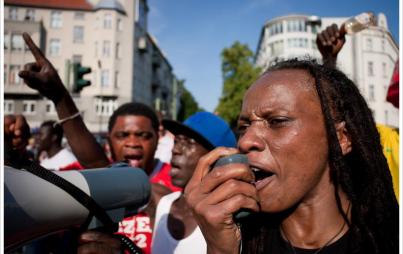
Young white people in Brooklyn represent a brand. That brand could be called “The Other Brooklyn,” a mythical sweet life of cornucopias crammed with organic coffee beans, craft beer, and vegan red velvet cupcakes.
My ex-roommate wears her head half-shaved and is of “straight-up white” descent. The other day, she told me about an incident at the local ethnic produce store.
To be clear, the broccoli and apples are not ethnic. The owners, staff, and majority of the clientele who shop there are. As she bagged Granny Smith apples, someone within earshot not so secretly whispered, “There goes the neighborhood.”
Folks rail the most against “types.” A white girl with a shaved head living in a non-white neighborhood is a type. She is also a gentrifier. It doesn’t matter whether she is a starving artist, or whether she works in finance. The color of her skin represents something bigger than herself. She’s the brass ring, money in the bank, and social mobility.
Brooklyn, New York in 2015 is a cartoon on class and race — one in which every panel is titled gentrification. To grocery store whisperers, the topic of young white people in Brooklyn is a knee-jerk reaction to the general idea of white folks that, as with my friend, unequivocally represent the fulfillment of the promise of American upward mobility.
After some beard-stroking on my part, I marveled at how untrue this was as a rule. Young white people, especially the percentage of them that are likely to have high student loan debt (read: 99% of them) are on a pretty shaky boat with everyone else here in Brooklyn. Everything is eye-wateringly expensive and free passes to the chocolate factory of prosperity aren’t given out on merit of race alone. However this pernicious idea seems to gain steam the moment someone demands to know where the craft beer section is in the Mexican bodega, or makes a beeline for the avocados. That’s when beard-stroke number two hit. . .
Young white people in Brooklyn represent a brand. That brand could be called “The Other Brooklyn,” a mythical sweet life of cornucopias crammed with organic coffee beans, craft beer, and vegan red velvet cupcakes. There is a cartoonish aspect to this portraiture. The majority of white people I know (at the time of writing this article) live un-extravagant lifestyles. The other ones, young professionals visibly stoked on living the life of Riley, whilst clad in flannel and putting dents in their iPhone screen from vigorous Tinder usage, represent real cash. Real cash enunciates the vowels of its presence so crisply and clearly that people who make a living branding and selling things know when it is around.
This is where Edward Bernays comes in. Bernays, a somewhat obscure dude and 20th-century man, wrote the playbook for PR and branding in the 21st century. His basic concepts were that allegiance to a brand is easily molded and modified, and that the average person does not know what they want until it is presented to them as a tantalizing option. If it seems like these ideas are a bit grand and vaguely smell of psychoanalysis, you would not be alone in that sentiment. Bernays’ uncle was Sigmund Freud.
Bernays built his career on exploring people not as individuals, but as types or groups. What would Bernays have to say about the brand of “The Other Brooklyn”? He’d probably book himself solid for a month just to puff congratulatory cigars with the overlords of Brooklyn commerce. The most successful set trends as restauranteurs, clothing boutique owners, and gallerists. They see Brooklyn as an hourglass, knowing exactly how many grains of sand go into the hourglass, when to break the glass, take out the sand, and how to rebottle it and sell it back to Brooklynites.
But I digress — this article began with food. I like my local grocery because like my friend, I shop there to live within my means. I don’t need the perpetually-shined floors of the organic grocery that charges $3 for a donut. I don't need a sticker on my tomatoes labeled with the elite prefix “9” for organic. And I don’t need to buy a premium bottle of water labeled “The Other Brooklyn,” bottled for me by Edward Bernays from beyond the grave.







